#Māori and Pacific values
Explore tagged Tumblr posts
Text
Tapatoru's Fresh Take on Professional Learning: Shaping the Future of Education
Ready to dive into how this programme is revolutionising professional learning for tertiary educators in Aotearoa New Zealand? Let's go!
Ready to dive into how this programme is revolutionising professional learning for tertiary educators in Aotearoa New Zealand? Let’s go! Tapatoru – A Fresh Approach to Teaching Picture this: a programme that’s not just about learning stuff, but also about weaving Māori and Pacific values right into the heart of education. We’re talking literacy, numeracy and neurodiversity, all rolled into…

View On WordPress
#adaptive learning#Adult Learning#Ako Aotearoa#blended learning#Cultural Inclusivity#cultural integration in education#cultural respect in teaching#educational strategies#educational transformation#future of education in Aotearoa#innovative teaching methods#interactive learning#Maori traditions in education#Māori and Pacific values#New Zealand tertiary education#professional learning development#Reciprocal Learning#Reflective Practice#Tapatoru Programme#teaching excellence
0 notes
Text
i hope scotty morrison makes a million billion dollars from his Māori Made Easy book series. these workbooks and phrasebooks are so god damn useful and so god damn affordable. literally all you have to do is 30 mins a day. theres website links for online portions of learning. theres so many copies at the library and so many books for different levels. this has been the perfect kickstart beyond basic Te Reo for me and is going to be so god damn useful for the Te Reo/language portion of my Early Childhood Diploma
#theres a heavy emphasis on māori and pacific values which is good because a large amount of students#are going to be māori or pasifika and you NEED to know these things of you want to teach them and help them thrive
2 notes
·
View notes
Text
Top 10 Pacific Islands Materials in Our Collection
While Pacific Island cultural experiences are far and few in Iowa, Special Collections & Archives is the proud host of a number of rare and highly regarded publications by prolific Pacific Islander creators or about the rich histories and cultures of the islands!
Te Kuia me te Pungawerewere (The Kuia and the Spider) by Patricia Grace.


(X-Collection Folio PZ5.G73 K85 1981, X-Collection FOLIO PZ5.G73 K853 1981)
Patricia Grace’s Māori children’s book, Te Kuia me te Pungawerewere, it’s English language version titled The Kuia and the Spider, is the tale of a Kuia, meaning elderly woman or grandmother in English, and a spider who share a kitchen and are in a constant playful argument of who is better than the other. Patricia Grace, a former school librarian herself, is a famed Māori writer of novels, short stories, and children’s books. The publication of this book in both English and te reo Māori, the Māori language in the 1980s was of great importance to language revitalization efforts following the presentation of the Māori Language Petition in 1972 and the officialization of Māori Language Week in 1975. Te Kuia me te Pungawerewere was awarded New Zealand Picture Book of the year in 1982 and remains a beloved story by Māori educators and families.
Tongan Ngatu.


(MsC 913)
Ngatu, or ngatu hingoa, in the Tongan language refers to the elaborately decorated tapa bark cloth tapestries of Tongan cultural significance. The art of ngatu is made distinct through processes of dying, stamping, and hand painting the tapestries, though still similar to the artful practices using tapa bark cloth in other Polynesian islands. The ngatu held in Special Collections was likely created in the 1940s, during or after World War II, and includes illustrations of planes to commemorate the contribution of the Tongan Defense Force to the British war effort. The tapa, or bark cloth itself, is likely made from mulberry tree bark, commonly used in the Pacific for this exact craft. Illustrations and stamping was likely done with dyes made from saps of other native Tongan plant species, such as candlenut trees.
Roma Potiki by Roma Potiki.
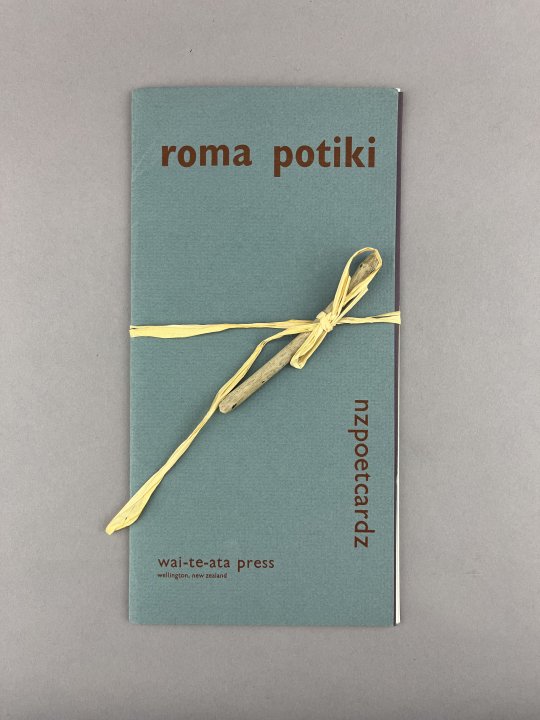

(X-Collection Folio PR9639.3.P59 R6 1996)
Roma Potiki is a noteworthy contemporary Māori poet, playwright and performer. Her self titled collection of poetry explores themes and topics of nature, the human spirit, Māori womanhood, politicization, and the lasting effects of colonization. The poems in this limited collection were also published in her 1998 collection, Shaking the Tree.
Death and the Tagua by Alistair Te Ariki Campbell.


(X-Collection Folio PR9639.3.C275 D4 1995)
Alistair Te Ariki Campbell is famed New Zealand poet and playwright of Cook Islands Māori descent. This collection of poems, Death and the Tagua, is the artistic account of and response to Campbell’s own journey from Rarotonga in the Cook Islands to New Zealand via a Tagua sailing vessel, and the deaths of both of his parents in his early life. More information about the Death and the Tagua can be found in our YouTube series, Nibbles of Knowledge.
Tapa: the bark paper of Samoa and Tonga by Lilian Bell & Ulista Brooks.



(Smith Miniatures Collection TS1095.S36 B45 1979)
Tapa is the bark paper or cloth of Polynesian islands including Samoa and Tonga, as specifically shown in this miniature book of paper samples. The bark of mulberry trees among other plants is processed into a fibrous paper, that is often then ornately decorated with dyes for cultural customary or celebratory purposes. In Tongan culture, these decorated tapa are called ngatu, and in Samoan culture, called siapo.
Whanau by Witi Ihimaera .


(X-Collection PZ5.I35 W43 1974)
Whanau, meaning family in te reo Māori, is a story of just one day in the lives of a large family living in a rural Māori village, struggling with the loss of traditional values and ways of living due to colonial pressures. It is the second work published by Witi Ihimaera, who is considered one of if not the most influential Māori writer still today. He was the first Māori writer to ever publish both a novel and book of short stories. The story takes place in the small town of Waituhi, were Ihimaera himself was raised and inspired to become a writer after seeing the erasure or mischaracterization of Māori in literature in New Zealand and globally. Our copy is signed by Ihimaera, with a note to the book’s donor, Carmon Slater, that reads “To remind you of a wonderful partnership and warm time at Tokomaru Bay when we worked on improving the self image of Māori Children.”
Ethnic Foods of Hawai’i by Ann Kondo Corum



(Szathmary Collection TX724.5 .H3 C68 1983)
Ann Kondo Corum, formerly a school librarian in Honolulu, wrote and illustrated Ethnic Foods in Hawai’i to provide a sense of history and culture through the foods and cooking traditions of the now multi-racial state of Hawai’i. She saw a need for this during her time as a librarian, when students had trouble finding information about the foods and culinary customs of their peers. This cookbook dives into the history and popular traditional recipes of the major cultural groups on Hawai’i, including traditional Hawaiian and Samoan recipes, celebrations, and culinary customs.
Māori Legends illustrated by Manu Smith.


(Smith Miniatures Collection GR375 .M36 1993)
This miniature book is the illustrated telling of major Māori legends or oral histories, including those of Maui, Pania, and Rona, the woman who went up to the moon. Illustrations are done by Manu Smith, who is also known for having illustrated Māori legends series for New Zealand stamps and phone cards in the 1980s and early 2000s.
Standing Place by Fred Hagstrom.



(X-Collection Oblong N7433.4.H25 S73 2012)
Fred Hagstrom is an artist and Professor Emeritus of Art and Art History at Carleton College in Minnesota. Standing Place is an artistic telling of a story about shared culture and the soldiers of the Māori Battalion during World War II. This covers the story of Ned and Katina Nathan, who are also the focus of Patricia Grace’s book, Ned and Katina. In his artist statement on the piece, Hagstrom writes: "I take students to New Zealand every two years, and in doing that have made good friends at a Maori Marae, which is a tribal meetinghouse. This is the story of their parents. … They also founded the Marae that I visit. This book is made in the friendship I feel for this remarkable family." The Marae in mention is the Matatina Marae at Waipoua. The kawai pattern on the book’s cover, titled Tatai Hono (the joining of lines of descent) was designed by Manos Nathan, son of Ned and Katina.
Francis Wherahiko Rawei, from the Redpath Chautauqua Bureau Records



(MsC0150 Box 238, Box 272)
Francis Rawei, also known by his former name Wherahiko Rawei or his stage name Dr. Rawei, was a Māori performer and educator of the early 20th century. Alongside his wife Hine Taimoa, a lecturer, harpist and singer herself, he toured internationally lecturing, singing and story-telling about Māori history, life and culture. Together they toured the United States and Canada on the Chautauqua circuit and lived briefly in Chicago before eventually returning to New Zealand.
Also worth mention are the many travel diaries and publications collated by some of the first foreign seamen to arrive in the South Pacific. I have very intentionally not included any of these materials, as these diaries are predominantly accounts of travel to these islands with the goal of imperial conquest or religious purification of Indigenous Pacific Islanders, and unfortunately are not without deeply racist and offensive language. This undoubtedly makes these materials challenging to read and engage with, but the effects of colonialism and religious missionary efforts are very real and prominent parts of Pacific Islands history, as well as our present day. Their place in a rare book repository is just as important to the preservation of Pacific Islands history and culture as those included on this list.
--M Clark
#special collections#uiowa#miniature books#rare books#uiowaspecialcollections#libraries#maori#pasifika
27 notes
·
View notes
Text
Pacific Indigenous leaders have a new plan to protect whales. Treat them as people
For Māori conservationist Mere Takoko, “losing one whale is like losing an ancestor.” The animals “taught our people about navigation across the Pacific, particularly across the Milky Way… And this is information that was given to our ancestors.” The environmental activist from the small town of Rangitukia, on New Zealand’s east coast, is spearheading a movement of Indigenous groups in the Pacific pushing to protect the magnificent marine mammals, inking a groundbreaking treaty to make them legal persons with inherent rights. The document is part of a multi-pronged effort to safeguard whales, which also includes quantifying their monetary value as carbon-depleting “bioengineers of our oceans”, and deploying the latest tech to track boats that harm them. While the declaration is non-binding and would still need government recognition to become law, conservationists hope personhood will lead to enhanced protection for these creatures, with many species endangered. “Our mokopuna (grandchildren) deserve an ocean brimming with life, where the melodies of whales echo across the vast expanses,” Māori King Tūheitia Pōtatau said at the signing of the treaty in the Cook Islands. Along with the Māori of New Zealand and groups from the Cook Islands, Indigenous leaders from Tahiti, Tonga, Hawaii, and Easter Island signed the He Whakaputanga Moana treaty. According to the document – whose name means Declaration of the Ocean – granting personhood to whales ensures them freedom of movement without enduring “mental suffering caused by human activities,” and the entitlement to inhabit a healthy environment “free from pollution, unsustainable fishing practices, ship strikes and climate change.”
[keep reading]
14 notes
·
View notes
Text
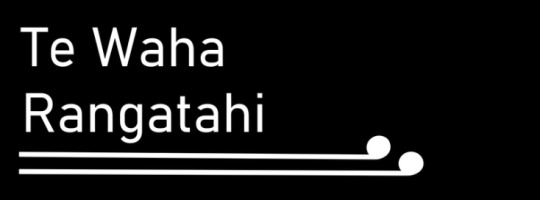
CONSEQUENCES FOR CRIME
Sentencing reductions in New Zealand come in different forms, such as parole, remission for good behavior, home detention, and community-based penalties. These policies aim to find a balance between punishment, deterrence, and rehabilitation, while also ensuring public safety. When offenders are released, they may have some restrictions, like electronic monitoring, and the impact of victim statements can influence sentencing decisions.
The legal basis for these policies is the Sentencing Act of 2002, which highlights values like community protection, offender accountability, and fair punishments based on the severity of the offense. It's important to stay updated on the current legislation and guidelines, as the approach to sentencing reductions and criminal justice policies in New Zealand may evolve over time.
Currently, this is a topic of great political debate, with the National Party proposing stricter punishments to address the crime situation in Aotearoa. Their policy includes placing a maximum limit on sentence reductions, implementing harsher terms for convicted criminals, providing increased support for victims, and ensuring proper rehabilitation for remand prisoners (Luxon, 2023). This proposal has sparked various arguments, and I'll share some of them with you.

The government has taken some steps recently to lower the number of people in prison, like using more home detention and community sentencing. These measures, though, haven't been enough to offset the growing number of people being sent to prison. So, New Zealand's prisons keep getting bigger, and now the country has one of the highest incarceration rates in the OECD. This is especially concerning because Māori and Pacific Islanders are overrepresented in the criminal justice system. (Ministry of Justice, 2022)
There are a bunch of things that people say contribute to this high rate of putting people in jail in Aotearoa. Some potential good things that could happen are: making sure that there's less room for judges to decide things on their own, so that similar cases get treated the same way. And maybe this could help reduce the chance of unfairness or discrimination in sentencing. Also, when judges have less discretion, the justice system becomes more open and accountable, because judges have to follow the rules that are already set. Maybe the National Party has a point?
But there are also negative things and responses to what the National Party is proposing. For example, Labour has spoken out and said that National's policy has been used over and over again for many years. (Ensor, 2023) Plus, National got criticised for not thinking about how much it costs to keep people in the correction system.
The formulation of sentencing policies is heavily influenced by political discussions. These conversations happen in various settings, from media outlets to legislative chambers, and they have a big impact on the development and modification of sentencing laws. Cases or incidents that are reported publicly and catch the public's attention often lead to intense political debates. When the public raises concerns about perceived injustices in sentencing, politicians may feel pressured to examine and revise current policies. Advocacy and interest groups with different perspectives can greatly influence the direction of sentencing policies and contribute to these political conversations through lobbying and advocacy efforts.
With that being said, when we limit judges' discretion in sentencing, it can have a big impact on Māori and Pasifika communities because they are considered to be overrepresented in the system. By reducing judges' discretion, it may mean that they are unable to take into account cultural aspects that have an impact on the rehabilitation and reintegration of indigenous Māori into society, such as their connections to their land and community. This can lead to a one-size-fits-all approach to sentencing that doesn't address the unique circumstances and needs of Māori and Pasifika offenders, which can potentially continue the cycles of reoffending and marginalization within these communities. Additionally, when we limit judges' discretion, it may undermine the principles of restorative justice, which prioritize healing and reconciliation over punitive measures, and this can further worsen the unfairness faced by indigenous populations in the criminal justice system. (Tauri, n.d.)
Public opinion plays a big role in shaping decisions on sentencing policies. When policymakers make choices about which direction to take with policies, they often take into account what the general public thinks and wants. It's important for sentencing policies to align with public sentiment because it can greatly improve the chances of getting re-elected for politicians. Surveys and polls are key in figuring out what the public thinks about sentencing issues, and they give policymakers important data to help them make decisions. Public sentiment can also push for changes in the criminal justice system. When people are worried about things like mass incarceration, racial disparities in sentencing, and whether or not the current sentencing policies actually work, they can put pressure on lawmakers to make real changes. For example, if surveys show that people are really unhappy with how the sentencing system is working, elected officials might feel like they have to do something about it in order to keep the support of the public. On top of that, public sentiment can also influence how resources are allocated. Instead of only focusing on punishment, people's opinions can help guide the allocation of resources towards programs that focus on rehabilitation as an alternative.
Ideologies of political parties have a big impact on strategies to reduce sentences. Policies about sentencing are heavily influenced by the ideology of the coalition or party in power. Conservative political ideologies often stress the importance of maintaining law and order and promote strict guidelines for sentencing as a deterrent. They might be against reducing sentences and prefer a "tough on crime" approach. On the other hand, progressive or liberal parties focus more on reducing sentences and implementing rehabilitation programs. Their main concerns usually revolve around prison overcrowding, racial disparities in sentencing, and the human toll of harsh sentencing guidelines. Sometimes, bipartisan collaboration can lead to improvements in sentencing that bridge conservative and liberal philosophies. Initiatives for criminal justice reform, particularly those related to mandatory minimum sentences and alternatives (Travis et al., 2014).
With a bunch of different opinions and arguments for and against the policy that I've mentioned, the talk about reducing sentences in New Zealand can get pretty complicated and nuanced. Some people say that reducing sentences might result in punishments that don't really show how serious the crime was and make people lose faith in the legal system. On the other hand, some folks believe that it can help with restorative justice and rehabilitating offenders.
0 notes
Video
Kanile'a KPA-B Mastergrade Baritone Ukulele "Kaimana" from Uke Like The Pros on Vimeo.
Discover the Unmatched Beauty and Sound of the Kanile'a KPA Mastergrade Baritone Ukulele!
Get ready for a musical journey like no other as Terry Carter Music Store proudly presents the Kanile'a KPA Mastergrade Baritone Ukulele - the ultimate choice for ukulele and guitar players seeking that bigger, richer sound.
In this video, you'll witness the enchanting design of the Kanile'a KPA Baritone Ukulele, featuring a mesmerizing Abalone Rosette and Ebony Binding that's as beautiful as it is melodious. And guess what? You get the exact ukulele you see in the video and photos!
But that's not all! By owning this incredible instrument, you become a part of a Hawaiian tradition, as Kanile'a plants a koa tree with each ukulele sold, ensuring a legacy of Aloha and environmental sustainability.
Prepare to be blown away by the unparalleled sound, feel, and playability of the Kanile'a KPA Baritone Ukulele. Crafted with the finest koa wood in the world, this ukulele is a true masterpiece, expertly made by skilled luthiers in Hawaii.
And there's a special surprise! The Kanile'a KPA Baritone Ukulele features a thick pāua rosette on curly koa wood, a stunning fusion of Māori and Hawaiian cultures. It's a celebration of the Pacific Ocean waves and the beauty they hold.
With Mastergrade Koa wood, you'll own an instrument that's as unique as you are, showcasing awe-inspiring grain patterns and captivating swirls. This ukulele is not just an instrument; it's an extension of your individuality.
For over 25 years, Kanile'a has been dedicated to crafting top-of-the-line Hawaiian Koa baritone ukuleles, rooted in tradition, family values, and the spirit of Aloha. Elevate your musical experience with an instrument that will become a cherished part of your life.
� Key Specifications:
Mastergrade Grain Solid Koa Body Thick Paua Abalone Rosette with Tortoise Trim Ebony Fingerboard, Bridge, and Head Plate Kanile`a Gold Geared Tuners 16:1 Ratio Tuned: D-G-B-E with Low D Kanile’a Limited Lifetime Warranty Don't miss this opportunity to own the Kanile'a KPA Mastergrade Baritone Ukulele.
Visit TerryCarterMusicStore.com now and experience the magic for yourself!
Get this Kanile'a KPA Mastergrade Baritone Ukulele terrycartermusicstore.com/products/kanilea-kpa-mastergrade-baritone-ukulele-solid-koa-kaimana-made-in-hawaii
Terry Carter Music Store operates both online and at their physical music store in San Diego. While the online store caters to a global audience, our San Diego music store proudly serves a wide range of local neighborhoods including Kerney Mesa, Clairemont, Tierrasanta, Murphy Canyon, Scripps Ranch, Serra Mesa, Linda Vista, La Jolla, Mira Mesa, Miramar, Poway, Rancho Peñasquitos, Sabre Springs, University City, Del Mar, Solana Beach, Sorrento Valley, North Park, Hillcrest, Birdland, Bay Ho, Allied Gardens, La Mesa, and Chula Vista.
Terry Carter Music Store proudly carries KoAloha, Martin, Guild, PRS, Kanile’a, Gibson, Fender, Kamaka, Axler, Uke Like The Pros, Cordoba, Kala, Ohana, Flight, Romero Creations, Blackstar, Korg, Vox, Orange, Sterling, Buy Strings Online, Worth, D'Addario, Aquila, Ernie Ball, Elixir and Dunlop.
A7 Music School an Music Lessons is inside Terry Carter Music Store in San Diego.
#terrycartermusicstore #baritoneukulele #kanileaukulele
00:00 Intro Playing 00:33 Mastergrade KPA 00:57 Kaimana Souza 01:35 KPA Baritone 02:02 Mastergrade Koa 02:59 Outro Playing 03:15 Top Of The Line
0 notes
Text
Art in the Public
“ Waharoa “ by Selwyn Muru
"This carved wooden gateway welcomes all people to Auckland’s Aotea Square, featuring mythological figures, symbols and even a haiku expressing Māori and Pacific culture."
This scultpure provides a gateway into Aotea Square, a gathering place and stage for public events.
To achieve the green colour on the forms near the top of the archway he treated pieces of weathered copper with vinegar. Some of the copper came from the top of the old Waitangi wharf piles, and by using it Muru acknowledges Tangaroa (god of the sea and fish) and his birthplace of Northland. The archway shows another four figures, also representing Māori atua (gods); Tamanuiterā (god of the sun), Tangaroa (god of the sea and fish), Tāne-mahuta (god of the forests and birds) and Tāwhiri-mātea (god of the winds, clouds, rain, hail, snow and storms). Representing heavenly bodies on the far left is Whetu me te Mārama (the stars and crescent moon). The body of the archway also features numerous symbols, highlighting Pacific and contemporary themes.
This artwork shows that the creator behind values the Maori culture.

“East Meets West” by Flox

“Maunga” by Shane Cotton
The works were commissioned by the Britomart Arts Foundation in collaboration with Nigel Borell, curator of Māori Art at Auckland Art Gallery Toi o Tāmaki.

0 notes
Text
For those who know how to read them, the signs have long been there. Like the towering mound of 20 million oyster shells all but obscured by the lush greenery of central Florida’s Gulf Coast. Or the arcing lines of wave-weathered stone walls strung along British Columbia’s shores like a necklace. Such features, hidden in the landscape, tell a rich and varied story of Indigenous stewardship. They reveal how humans carefully transformed the world’s coasts into gardens of the sea -- gardens that produced vibrant, varied communities of marine life [...]. And in certain places, like on the west coast of North America in what is now Washington state and where the Swinomish are building a new sea garden, these ancient practices are poised to sustain them once again.
“I see it as a way for our people to be reconnected to our place, to be reconnected to each other, and to have a purpose, to have a responsibility that goes beyond us,” says Alana Quintasket (siwəlcəʔ) of the Swinomish Tribal Senate.
---
Across the planet, Indigenous communities, from the Heiltsuk in British Columbia, to the Powhatan on the Chesapeake Bay on the United States’ Atlantic Coast, to the Māori in New Zealand, have successfully stewarded the sea [...]. These communities avoided diminishing their productive sea gardens despite, in some cases, seeing harvests that rival modern commercial fisheries.
The scale of historical Indigenous oyster gardening, for instance, cannot be overstated. On America’s southeastern Atlantic coast, in the modern states of South Carolina, Georgia and Florida, Indigenous peoples whose descendants include the Muscogee built gargantuan monuments out of oyster shells. These structures could reach 30 meters high or more. [...]
In 2004, scientists studying historical overfishing published a study showing how, starting around the 19th century, oyster stocks suffered a “moving wave of exploitation” that traveled down the Atlantic and Pacific coasts of North America and the eastern coast of Australia. The capitalist commercial fisheries that arrived with European colonization and settlement, Rick says, undid thousands of years of sustainable prosperity. “Within 50 years, 100 years, maybe even less in some areas, they’ve depleted that stock.” But to Rick, that modern narrative of rampant decline is only part of the story. [...] To fill in the rest of the story, Rick assembled a diverse, multidisciplinary team of researchers to revisit the history of oyster fishing in the same places [...].
---
The work adds to scientists’ growing understanding of the diversity and value of Indigenous approaches to marine stewardship. Like the oyster gardens, similar systems show up again and again around the world, from Native Hawaiian loko i‘a (fishponds) and Haida Gwaii naw náaGalang (octopus houses) to the shi hu (stone fish traps) of Taiwan and corrales de pesca (fish traps) of Patagonia. These and other examples are being cataloged by a broad collaboration, known as the Pacific Sea Garden Collective, that is working to map this diversity of Indigenous sea gardening innovations across the Pacific Ocean.
In her own work studying historical Indigenous clam gardens on the North American west coast, which date back at least 3,500 years, Anne Salomon, an applied marine ecologist at Simon Fraser University in British Columbia, has noted some of the key techniques that led to these bountiful yet restrained returns. People would till the sediment, replenish shells in the water, and construct low intertidal rock terraces that flatten the shoreline and expand the farmable area. [...]
---
To Salomon, who is involved in the Pacific Sea Garden Collective, the intensive nature of some Indigenous sea gardens is fundamentally different from the maximum sustained yield mindset of today’s capitalist commercial fisheries. Archaeological evidence, paired with Indigenous oral histories, Salomon says, shows how by focusing on common reciprocal, relationship-based principles and governance practices — ones that sustain individuals, communities and their environments — Indigenous communities often made decisions that led to huge harvests while also putting some limits on the scale at which that intensification was happening.
These gardening efforts included a continuum of features, such as seasonal or size limits on harvest, that may be invisible to the eye, Salomon says. And as Marco Hatch, a member of the Samish Indian Nation and a marine ecologist at Western Washington University who was involved in Rick’s study of oyster gardens points out, “These features aren’t just physical features, they’re cultural features and spiritual features.” [...]
---
Inspired by sea garden restorations led by Indigenous communities in British Columbia, the Swinomish Indian Tribal Community has just received permits to start raking sediment and rolling rocks at a site on its traditional tidelands on Kiket Island, roughly 125 kilometers north of Seattle. For years, tribal members were chased away with guns and dogs and prevented from harvesting in the area, says Swinomish tribal member and shellfish community liaison Joe Williams (Squi qui). “It’s a very special time for us to be able to reacquaint with this particular location,” he says.
This sea garden should help address recent declines of butter clams, littleneck clams and Olympia oysters, and help those populations adapt to climate change. Historically, Indigenous peoples would shift the locations of clam garden rock walls as sea levels changed. Gardens also protect clams against ocean acidification and potentially against extreme temperatures.
---
Text by Ashley Braun. This story was originally produced for Hakai Magazine. Braun’s text here appears as published/re-published by Crosscut with the title “Indigenous sea gardens fed communities, preserved ecosystems.” 3 August 2022. [Bold emphasis added by me.]
151 notes
·
View notes
Note
Hi, Hello! I just read (probably) most of your current blog (I saw that your previous blog was purged by Tumblr, sorry to hear that.. Glad you're back!) but not yet all the fics, but I think that holy macaroni, it's AWESOME! They sound human yet *not*, and how you tie their headcanons based on actual historical interactions!! If it's okay, I would like to ask about Zee and Jack. How's their relationship with Arthur's other colonies and neighbors in Asia and Oceania (continent)? Like, are they mostly estranged from the other colonies, or do they find some kind of kinship in their situations? (I heard that many Malaysians and Singaporeans, along with other SEA neighbors of theirs. It's funny how it's made in Australia but most consumed in that area).
Okay, I am so sorry, this has been in my box for like a month but better late than never, right? and Thank you! I'm very glad that's satisfying for you! And oh, very good question. I'm not sure what you were referring to that Australia makes that popular in Malaysia and Singapore, I'm going to guess it's Milo or maybe Vegemite. But I'm not sure, so I will try and answer this without that info, and I'm going to be speaking in broad generalizations. I am from the opposite end of the Commonwealth, and I am not all-knowing so this pretty birds-eye-view and not a Kiwi flightless bird sort of bird's eye view.
So it's both. Stiff and friendly, slightly estranged but also close. Geography puts them in the Asia-Pacific. They have a lot in common with their neighbours. In general, it's good, but it's also complicated. In a lot of ways, Jack and Zee float in their little bubble down there, but they have very different outlooks on this. But they are both friendly and on good terms with their neighbours. Jack and Zee both are very casual people; they're friendly overall. Both because they value egalitarianism but also because they embodied unique positions as they grew up. Both have large populations of European origin while being much farther from Europe than North America. So they tend to orbit each other more than other neighbours because they both get a lot more of a say in imperial policy than their neighbours. Their current relations are still affected by the imperial rank they were both given as dominions. New Zealand and Australia were both mini-empires within the British Empire, being delegated roles of power over some of their neighbours. New Zealand governed several islands and still does, Australia has a similar role, and both play a powerful role in projecting what used to be British Imperial power and is now somewhat more multilateral but still very much a continuation of that role.
Jack, on the surface, gets on well with his neighbours; he's friendly, egregious, and hard not to like. He's good at making people feel included; he's good at having fun. Like it's hard not to have a good time around him, but he is also a son of the British Empire and something of a cadet to the American Empire. He's very casual, and there's at least a pretence of equality he prefers to act on, but these power dynamics are still a part of his relationship with his neighbours. He doesn't like thinking about it much; the childhood he had and his relationship with Brighid made an impression on his brain in such a way that he can be pretty unaware of how much power he actually has and how his ability to be casual and show no deference is in itself a privilege. But he'd get on quite well with Singapore and Malaysia. He is a bit blind about his placement and doesn't understand why they can be stiff, much more so earlier in history than now.
Zee is more aware. Her life and existence are more of a duality. Jack had no founding treaty, and the British rolled along because they didn't much care as long they had a place to shove convicts. Whereas Zee was at least theoretically founded as a state of co-sovereignty. Is that how it played out for the Māori most of the time? No. It gave them, at least legally, more rights than indigenous people in other settler colonies. They didn't have it easier than other indigenous people, but they were more successful long-term and fought like hell at every step. So Zee is Polynesian. The Māori are Polynesian. Zee's worldviews are very much a duality, and I think that made her more aware of her position. It didn't always play into her choices, and she is still relatively powerful in her sphere. I think she spends more time with her neighbours and is more aware of their linguistic and ethnic complexities than Jack tends to be. Tonga, Fiji, New Caledonia, Malaysia, and Singapore, they're friendly. She's less perky, sunny or social than Jack but also much more aware and emotionally intelligent than he is.
#Jack || a land of summer skies#Zee || ahakoa he iti he pounamu#Jack and Zee || pieces of me across the Tasman sea#set the sea aflame || dynamics in the pacific
28 notes
·
View notes
Text
Tapatoru Ako Professional Practice: Empowering Tertiary Education with Ako Aotearoa's Innovative Programme
Explore the 2023 advancements of Ako Aotearoa's Tapatoru Programme. Discover how it's reshaping tertiary education in NZ with inclusive, culturally-rich content. Join the conversation on fostering a diverse and future-ready educational workforce
Tapatoru Developments Let’s dive into something exciting that’s shaping the future of tertiary education in Aotearoa New Zealand. Yes, I’m talking about the latest buzz in town again – Ako Aotearoa’s Tapatoru Programme. For those of you who’ve been following, this is part three of our deep dive, and trust me, it’s a game-changer! You can go back and check out part one and part two if you…

View On WordPress
#Ako Aotearoa#Aroha#cultural values in teaching#Educational Accessibility#Educator Development#ESOL Teaching#Inclusive Education#literacy and numeracy#Manaakitanga#Māori Cultural Capability#New Zealand education#pacific cultural centredness#Pathways Awarua#Tapatoru Programme#Technology Enhanced Learning#Wairuatanga#Whanaungatanga
0 notes
Text

An interesting perspective of the Humphead wrasse, with its thick lips on display.
The Humphead wrasse (Cheilinus undulatus), also known as Napoleon or Māori wrasse, is a large coral reef fish widely distributed across the Indo-Pacific region. Males usually grow to an average length of 1 m but some are known to have reached up to 2 m and weighing up to 180 kg while females rarely grow larger than 1 m. This species can be recognised by its thick lips, the prominent bulge on its forehead and two black lines behind its eyes. The Humphead wrasse is crucial to coral reef health as its feeds on crown-of-thorn starfish which is a damaging coral reef predator. However, it is listed as Endangered on the IUCN Red List and in Appendix II of CITES. Its main threat is due to unsustainable and severe overfishing since it's a valued luxury food within the live reef food fish trade across Southeast Asia.
📷 garybrennand
www.instagram.com/garybrennand/
26 notes
·
View notes
Text
Some months ago a new student told me she had missed the first three weeks of lectures for the year because she didn’t have a suit. I asked what she meant, and she replied that, because she was studying to be a lawyer, surely she had to wear a suit to her lectures.
While humorous on one level, this anecdote is an example of what we call the “hidden curriculum”: the unspoken rules, behaviours and perspectives that can have a significant effect on the success or failure of students, and their levels of comfort in environments that may be new to them. While the explicit syllabus covers what is substantively taught, the hidden curriculum relates to social expectations of conduct and behavioural patterns, as well as deeper values and messages that are subconsciously conveyed about what is “normal” – which results in centralising and prioritising of particular cultural values, gender, sexuality, faith and class perspectives.
The hidden curriculum can include issues such as what to wear and forms of address – which may seem minor, but can cause embarrassment and discomfort if breached. The one time when suits are required in legal education is when students appear in mock trials or moots. Not being “appropriately attired” resulted in marks being deducted, which caused immense stress among students who had never owned formal wear or the means to buy it.
A group of my friends shared the one suit they had between four of them in their moot – which was made obvious by the fact that its owner was 6ft 4in and the suit was bright teal (it was the 90s – all the rage). I also recall the anxiety of not knowing what to call my lecturers, or whether it was OK to make contact outside the classroom and, if so, how – expectations that are more commonly communicated today.
The boundaries of professional relationships and behaviours are also culturally bound: an experienced teaching colleague who migrated from Scotland was initially mortified to see me sharing personal information and photos of my whānau in my classes, but has since learned that Kiwis in general are less formal than Europeans, and that such practices are key to engaging with Māori and Pacific students.
Ways of showing respect differ between groups – years ago I was puffing slowly uphill to a class across campus, and turned to tell the group of students who were lagging behind me to overtake. One young woman timidly said that they couldn’t: as Koreans, it would be disrespectful for them to place themselves in front of their teacher. We were all late due to me being unfit.
While we regularly review and reflect upon the explicit content we teach as educators, other things remain largely unquestioned, such as the role of the teacher, the geography of the classroom, how we test knowledge, and what we do when we don’t understand. The classical pedagogical method in law teaching is the Socratic method of question and answer – co-operative argument through questioning – which is challenging to many non-Westerners, many of whom actively avoid classes where it is used, for fear of being exposed.
And yet this method is assumed to be effective, known and understood – without any direct instruction. It may seem obvious to many that, if we don’t understand, we raise our hand and ask for clarification, and therefore our silence implies understanding and/or acceptance of what was said. Those assumptions do not apply across all cultures and ethnicities. Perceived class barriers also prevent some people from asking for help for fear of drawing attention to themselves.
Sexuality and gender identities are also relevant. Despite the general movements in social and legal acceptance of diverse sexualities over the past generation, for the most part textbooks, assessments and exams presume heteronormativity. I had never thought about this until a gay colleague wrote a same-sex couple into an exam paper this year, in which their sexuality was not relevant at all. In recent years I had been careful to include names from different traditions in assessments, but not sexualities – as a straight, cis-gendered woman, I have not seen the need.
Systems and processes often fail to recognise or provide for different cultural or faith priorities, such as family or community obligations, sabbath timings or requirements, and this can cause frustration, confusion and resentment. Knowing how to navigate the processes and practices of environments such as universities is not second nature to members of communities who have little connection or experience of them.
The connection to privilege is obvious – what sociologist Robert K Merton dubs “the Matthew effect” of accumulated advantage, in reference to the biblical verse from the Gospel of Matthew that can be summarised as “the rich get richer and the poor get poorer”. In relation to the hidden curriculum, this means the unarticulated rules confirm general power dynamics to further entrench privilege.
In his 2008 book Outliers, Malcolm Gladwell illustrates the impact of a lack of social and cultural capital in tertiary education through the example of Christopher Langan. Despite an IQ that left Einstein in the dust, working-class Langan bombed out of university due to seemingly minor hiccups – missing a deadline for financial aid and being unable to navigate how to make a timetable change. In my experience, these kinds of bumps in the road can trigger a fight-or-flight response in students like Langan, who catastrophise such events to affirm their inner narrative that they neither fit nor deserve to be at university.
Scrutiny of the hidden curriculum is important to recognise barriers to effective engagement and success. It may also uncover discrimination – and inconsistency in messaging – such as teaching Māori knowledge, divorced from a Māori context, values and practices. Good reflective practice requires ongoing questioning and analysis of why we do what we do.
Khylee Quince is associate professor of law at Auckland University of Technology.
1 note
·
View note
Text
Week 1 Independent Study
1.Have a first-up curious online broad research: what types of museums exist in areas you have potential interest; - The Louvre - National Gallery of Art - The Museum of Modern art - Tokyo Photographic Art Museum - Military Museums - City Gallery Wellington Top 3 Museums of Interest (collections and what they do) a.)Te Papa showcases newzealand local and international culture to us and travelers celebrates art and creative means as a form of documentation of historical events Focus on Pacific cultures and taonga Maori and respectful curatorial processes educates and informs “container of treasures” collect, exhibit and preserve heritage, science and achievement Collections: Marae 800,000 art pieces, taonga, collection objects , botanical and zoological specimen Anzac exhibition Toi Art Collection Highlights : https://collections.tepapa.govt.nz/

b.) Museum of Sex (NYC) prioritising the importance and cultural significance of preserving human sexuality immersive and educational experience including science, history, and art exhibits. offer a variety of fun and cultural exhibits that showcase different perspectives on sexuality. advocating open discourse surrounding sex and sexuality as well as striving to present to the public the best in current scholarship unhindered by self-censorship. Collection: the Museum of Sex preserves an ever-growing collection of sexually related objects that would otherwise be destroyed and discarded due to their sexual content. permanent collection of over 20,000 artifacts is comprised of works of art, photography, clothing and costumes, technological inventions and historical ephemera

c.) Venustempel Museum of Sex (Amsterdam, Netherlands)
Worlds 1st therefore oldest sex museum in existence
aims to reveal and illustrate the attitude people had towards sex from Classical Antiquity until the Victorian period
The museum looks at many aspects of sensual love through the ages, displaying an extensive collection of erotic pictures, paints, recordings, photographs and more. fun,laughs,light hearted entertainment, amusing examples of sex toys, pictures and general information on sexual persuasions kitsch yet informative Collections: quite historic artifacts and date exhibition nothing that really develops and ties in the 21st century navigating exhibitions
2.Visit museum or art gallery and sketch two maps;
Map 1 : 3 first works you naturally gravitate to Map 2 : Move the way the space intends for you to move


Differences and Similarities ;
map 2 ;cleaner, more efficient appears to make more sense fleshed out on a map. more vs less rooms visited different directions and flows What impact does the atmosphere have on your senses?
formal layout directs you straight to info desk open layout directs you straight to Hancock gallery sounds and obnoxiously big or interestingly intriguing works draw the eyes and ears Does gallery space contribute to your experience of items of display?
large space everything's quite distanced and has its own space to shine not interfering with experience of other works.
permitted to wander
3.
Core Text - Readings Notes
Lewis - History of Museum
institutions that preserve and interpret material evidence of human race, activity and the natural world innate human desire to collect and interpret and having discernible origins in large collections built up by individuals and groups before the modern era describing private collecting conducted in ancient and medieval times reviewing the development of modern public museums from renaissance to present day etymology classical origins greek “mouseion”seat of muses philosophical institution or a place of contemplation collection of curiosities established to preserve, display a collection to the public 18th century 19th//20th century the word museum denoted a building showing cultural material in which the public had access museums continued to respond to societies that created them -emphasis on building itself less dominant
ecomuseuems outdoor environment virtual; museums museology and museography- body of theory conversation and display conflict of purpose - lack of clear identity human propensity to acquire and inquire environment ,communication classical collections archeological and historical records don't provide evidence that museum life we know today developed in such earlier times religious,magical,economic,historical values sepcicailised personal collections interest in human and natural history spirit of system and rational inquiry toward the modern museum private, public,collection renaissance-symbols of social prestige tradition, nobility, ruling advancement of knowledge increasing world exploration not only for inspection and entertainment of learned and curious but for general use and benefit of public instruction and gratification public concern royal collections in France inaccessible to public European colonial influence influence of industry and science social reforms to overcome problems resulting from industrialization contributed to the development of municipal museums urbanized population legislation educational facility a source of leisure activity medium of communication inspire and voice a sense of wonder,reality ,stability and nostalgia increased awareness of the environment and the need to preserve it
Huhana Smith
Mana Taonga and the micro world of intricate research and findings around taonga Māori at the Museum of New Zealand Te Papa Tongarewa
-guide to practice of staff- collections of art ,cultural, natural ,historical material in context of Aotearoa museum studies -Maori curators involved in intricate and intimate research contemporary understandings how curators actively engage in research processes that re-enhance the inter-relationships between people and their cultural material indigenous cultures-colonial states mana taonga- principle acknowledges spiritual forces wairua,mana people, animals ,inanimate objects, symbols ,collection iwi,hapu ,whanau representation genealogical reference system methodological system tribal elders and leaders sensitive careful final verification on research findings personal adornment ceremony embodiments of an ancestral past with the responsibility to care for them in future prized personal possessions harmony peacemaking ancestral and or personal significance safe keeping, memories and associations passing on knowledge
1 note
·
View note
Text
Maori Tattoos
Background:
As seen in the hit movie Moana, Pacific Islanders were one of the first cultures to practice tattooing on a large scale. In fact, the English word “tattoo” is derived from the Tahitian, Tongan, and Samoan word “tatau” and the Marquesan word “tatu”. Of the Pacific Islanders, one of societies most infamous for their tattooing was the Maori people. The Maori are the indigenous people of New Zealand for whom tattooing, called “moko”, is a key pillar of their culture. (Deter-Wolf)
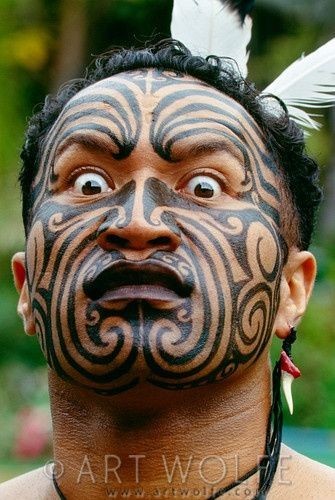
Origins of Moko:
There are many theories as to where moko began. Maori folklore states that moko was introduced when the spirit Niwareka fled to the Underworld after being struck by her husband Chief Mataora. Chief Mataora then followed her into the Underword where he was taught moko by Niwareka’s father, Uetongo. Another theory states that moko began when Maori women would cut themselves with shells or obsidian during mourning rituals and then fill their wounds with soot (Heritage Te Manatu Taonga). Yet a different theory proposes that moko began when lighter skin chiefs would tattoo their faces to blend in with their darker skinned slaves in battle and be less of a target. Finally, it’s possible that moko was used as a way to create permanent war paint to avoid the hassle of recreating it before each battle. No matter where it started, there’s no arguing that moko evolved into a beautiful art form and a critical part of Maori identity (Robley).
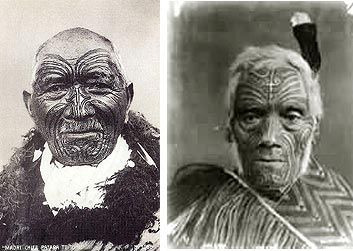
Moko as Strength:
A large part of the reason why moko holds such great cultural significance is because its process is a painful one that requires the strength of the wearer. Moko is created by tying chisels made of bone (called “uhi) to a handle that is then tapped into the skin with a mallet. After the wound is created ink made from charcoal and liquids from plants is deposited into it, resulting in a thick raised line (Heritage Te Manatu Taonga).

One of the reasons why the process of moko is so painful is because it was often used to represent wounds received in battle and so moko is meant to reflect that. Additionally, this function emphasizes strength as the user had the physical strength to endure battle but also the strength to support and sacrifice for their community. Another reason moko is known for being one of the more painful tattoo practices is because designs were tightly packed together and often covered most of the face, including the eyelids. The biggest thing that differentiates moko for Maori men and women is the size. Men often wore full body moko whereas women wore moko kauae, a smaller chin tattoo. This size difference along with the connotation of strength and moko emphasizes the sexist belief of a man’s strength over a woman’s in Maori society.

Moko as Art and Culture:
Moko designs were intricate combinations of spiral patterna and black-out design that covered the thighs, butt, stomach and face. Designs were similar to family crests in that certain patterns could only be used by certain families. Facial moko was the most valued as the face was the most sacred part of the body and a declaration of identity. In wearing facial moko, one was expressing great cultural pride (Robley). Another reason why moko was a source of cultural pride was because it was believed that the receiver visited the spiritual realm, met their ancestors, then returned as a new person (Heritage Te Manatu Taonga).

Moko was further solidified as a cultural identifier of the Maori people with the start of colonization. Because moko was such a great source of pride, most memorized their moko designs. And so when European colonizers requested the signatures of the Maori for documents, they would often recreate the pattern of their facial moko as their signature. Furthermore, moko was used to represent the Maori in messages. Chiefs would often communicate by sending symbolic items rather than written messages and so items with moko drawn onto them were used to represent the Maori people. For example, if a potato with moko and tobacco was sent from one Maori chief to another it meant it was an invitation to join a war party against a Maori enemy. The tobacco being represntative of an invitation to war, the potato signifier the enemy, and the tattooing or lack of being represntative of a Maori or European enemy (Robley).
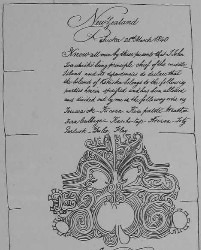
Moko Kauae:
While full body moko was worn mostly by men, moko kauae was still a source of pride for women. Moko Kauae is a chin tattoo representative of the coming of age of a Maori woman. It’s believed that the women wear their moko close to their hearts which is then brought to the surface by a moko artist when the women are ready. Similar to the large scale moko of Maori men, moko kauae is meant to display one’s inner strength although the smaller nature of moko kauae conveys the underlying belief that a woman’s strength is more subtle and less physical. Additionally, the process is associated with a coming of age devoid of battle wounds further emphasizing the belief that a woman’s value was not her strength.
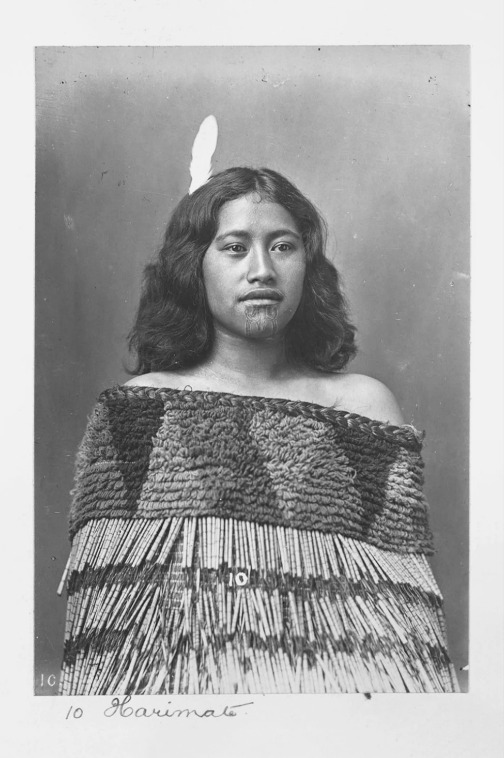
Suppression and Resurgence:
Beginning around 1840 British colonization of New Zealand began. They forced the Maori people from their land and to assimilate to British culture. During this time laws prevented the growth and spread of Maori culture, including moko (Duff). However, while the spread of moko was discouraged it was still recognized by the British as a beautiful and exotic art form and so heads tattooed with moko were often sold as souveniers and collector’s items. They became so popular that Maori were often killed specifically for their tattooed heads and the Maori people themselves would sometimes tattoo the heads of their slaves, kill them, and sell their heads (Heritage Te Manatu Taonga). Because of fear of death or persecution, moko began to die out and by 1970’s it was only seen on female elders and disaffected urban Maori people. Gang members would use moko as gang signs and it became correlated with gangs and crime. Because of colonization, this beautiful art form was twisted into something viewed as dirty and corrupt.
A revival of Maori culture began in the 1980’s with many people reclaiming moko as a cultural identifier. In particular, there’s been a surge of women reclaiming moko kauae. They’ve begun incorporating the carving designs of their tribe that survived cultural genocide and getting moko done with traditional tools rather than western ones as a way to connect with Maori culture. In 2016, Nanai Mahuta became the first member of parliament to wear moko kauae. In 2019, Oriini Kaipara became the first mainstream new anchor to wear moko kauae.
The use of moko kauae by these two prominent women who hold positions of power illustrate the gradual respect and acceptance of Maori culture in New Zealand. While cultural genocide seemed to work during the era of colonization, the unstoppable power of moko is allowing it to resurge (Duff).
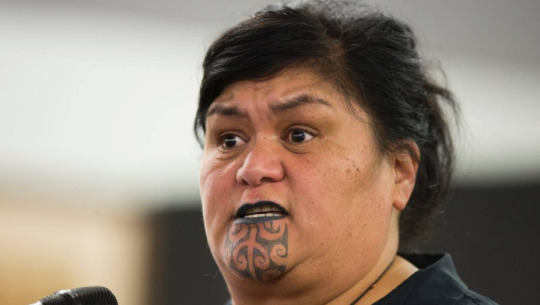

Deter-Wolf, Aaron. “Archaeological Evidence in Polynesia and Micronesia.” Ancient Ink: The Archaeology of Tattooing, edited by Lars Krutak, University of Washington Press, 2017, pp. 159–164.
Duff, Michelle. “'It's Transformative': Māori Women Talk About Their Sacred Chin Tattoos.” Vice, 13 Sept. 2016.
Heritage Te Manatu Taonga. “Tā Moko – Māori Tattooing.” Te Ara Encyclopedia of New Zealand – Te Ara Encyclopedia of New Zealand, Ministry for Culture and Heritage Te Manatu Taonga, 20 Dec. 2016.
Robley, Major-General. “Moko; or Maori Tattooing.” New Zealand Electronic Text Collection, 2016.
2 notes
·
View notes
Note
Hey I have a question about creating countries that are made up of islands, but not have seafood as a staple and vegetarianism is the norm among religious adherents and even among common people vegetarianism isn't unheard of. How can that make sense?
Tex: I don’t know how far back you want to look in order to find an island culture that doesn’t eat seafood or any other type of meat, but for the sake of context I’ll be throwing some darts around the map and see what island cultures typically eat.
I’ll start with Pacific Islanders and list a few of the cultures from the Pacific Ocean:
Polynesian region, composed of peoples such as the Samoans, Māori, Tahitians, Native Hawaiians, and Tongans
Micronesian region, composed of peoples such as the Carolinians, Chamorros, Chuukese, and Nauruans
Melanesian region, composed of peoples such as the Papuans, Moluccans, the Austronesian descendants in Vanuatu, and at a stretch the Torres Strait Islanders of Australia
These groups are roughly divided into two ethnolinguistic groups: the Austronesian peoples who speak Oceanic languages, and the Papuan peoples who speak the Papuan languages. For the most part, both groups are from Southeast Asia (the Papuan first wave was from the Malay Archipelago), and their linguistic origins reflect that.
It should be noted that none of these people ultimately originated from these island regions - they all came from part of a continent that was close to the Pacific Ocean. Ye olde ages ago did their ancestors decide to strike out and immigrate to new areas, and their diet adapted accordingly. Religions that ban the eating of things like shellfish and animals are a comparatively recent phenomenon, because it meant abstaining from an easily-accessible food source.
I’m going to momentarily branch off and list some island cultures of the Atlantic Ocean so my examples are a little more balanced:
Northern: Faroe Islands (Danish, sort of), Iceland, Baffin Island (Canada)
Eastern: Azores (Portugal), Canary Islands (Spain), Madeira (Portugal), São Tomé and Príncipe (Gulf of Guinea)
Western: Barbados of the Lesser Antilles, Prince Edward Island (Canada, a traditional island of the Miꞌkmaq), and Cuba (native lands of the Guanahatabey, Taíno, and Ciboney)
Antarctic region: Tierra del Fuego (Chile, native land to the Yaghan),
Many of these islands were close to nearby continents, and often traded with each other for resources, so there is cultural precedent of eating things other than marine life. A couple examples would be the Taíno, and the Kalinago peoples, both of whom originate from South America. The Yaghan “traveled by canoes between islands to collect food: the men hunted sea lions, while the women dove to collect shellfish”, so still ate some form of meat.
For a couple of Atlantic island examples that did not have indigenous people: the sailors who visited Ascension Island hunted the local birds and turtles for food, and those whole lived on Saint Helena imported livestock, fruit trees, and vegetables for the purpose of colonization.
Many, if not all, of these Atlantic islanders also ate meat of some sort, be it livestock from a continent, birds, fish, or shellfish. Historically speaking, meat of any sort was a cheaply-obtained food in terms of net caloric gain compared to net calories spent obtaining said food.
While the over-consumption of anything is bad, and red meats in particular are often touted as lending an increased risk for cardiovascular diseases - which a 2016 meta-analysis noted frequently occurred with a lifestyle risk factor (Citation 1) - red meat in moderation is fairly healthy (Citation 2, Citation 3). There is evidence that diet affects the activation of different alleles (phys.org), which is indicative of a population’s change toward agriculture (Citation 4), though in particular an overconsumption of carbohydrates can result in metabolic inflammation and obesity (ScienceDaily).
Humans are omnivorous by default, and require 20 amino acids in order to be healthy. The nine that the human body cannot produce must be consumed from an outside source - MedicalNewsToday does an excellent job of breaking this down and informing readers of viable sources of each of these essential amino acids. Unfortunately for those who might have abstained from meat before the invention of supplements, the healthiest diet for them was made with the addition of dairy products (Citation 5, eggs (The Incredible Egg, Citation 6), and fish (Seafood Health Facts 1, Seafood Health Facts 2, Citation 7)
As I don’t know the level of technology your countries, I cannot make the assumption that non-meat amino acids can be created and distributed to your populace in a relatively inexpensive manner. The nutrient density of meat vs non-meat foods is debatable (Citation 8), so I would hesitate to forgo meat entirely in a culture without some reason as to why an otherwise viable source of nutrition cannot be used.
Human nutrition is plainly a complex topic with many sub-specialities, and would take any one of us a very long time to adequately explain even a portion of it, especially in conjunction with anthropological factors such as geographic origin and developed cultural norms. I’ve added some more things to peruse in the Further Reading section below, but please be aware that all of this only starts to scratch the surface of what you’ve asked. If you would like to return with more precise questions, we’d be more than happy to try answering them.
Citations
PDF - Song M, Fung TT, Hu FB, et al. Association of Animal and Plant Protein Intake With All-Cause and Cause-Specific Mortality. JAMA Intern Med. 2016;176(10):1453–1463. doi:10.1001/jamainternmed.2016.4182
PDF - McAfee, Alison J., et al. "Red meat consumption: An overview of the risks and benefits." Meat science 84.1 (2010): 1-13.
PDF - Wyness, Laura. "The role of red meat in the diet: nutrition and health benefits." Proceedings of the Nutrition Society 75.3 (2016): 227-232.
PDF - Ye, Kaixiong, et al. "Dietary adaptation of FADS genes in Europe varied across time and geography." Nature ecology & evolution 1.7 (2017): 0167.
PDF - Rafiq, Saima et al. “Chemical Composition, Nitrogen Fractions and Amino Acids Profile of Milk from Different Animal Species.” Asian-Australasian journal of animal sciences vol. 29,7 (2015): 1022-8. doi:10.5713/ajas.15.0452
PDF - Hoffman, Jay R., and Michael J. Falvo. "Protein–which is best?." Journal of sports science & medicine 3.3 (2004): 118.
PDF - Ralston, Nicholas VC. "Selenium health benefit values as seafood safety criteria." EcoHealth 5.4 (2008): 442-455.
PDF - Bohrer, Benjamin M. "Nutrient density and nutritional value of meat products and non-meat foods high in protein." Trends in food science & technology 65 (2017): 103-112.
Further Reading:
Greater Antilles - Wikipedia
Gulf and sea island of the Atlantic Ocean - Wikipedia
List of Caribbean islands - Wikipedia
Amino acid synthesis - Wikipedia
“Microbial production of amino acids and derived chemicals: synthetic biology approaches to strain development.” - PubMed
Lobster history as prison food - Wikipedia
Religious restrictions on the consumption of pork - Wikipedia
Taeniasis/cysticercosis - World Health Organization
“How Dietary Supplements Work” - How Stuff Works
“Risks and side effects of dietary supplements” - American Cancer Society
PDF - ADVERSE EFFECTS OF NUTRACEUTICALS AND DIETARY SUPPLEMENTS by MJJ Ronis et al.
Dietary Supplements - National Institutes of Health (NIH)
“Evolution of tryptophan and its foremost metabolites’ concentrations in milk and fermented dairy products” by Antonella Bertazzo et al.
PDF - Associations of Maternal Vitamin B12 Concentration in Pregnancy With the Risks of Preterm Birth and Low Birth Weight: A Systematic Review and Meta-Analysis of Individual Participant Data by Tormod Rogne et al.
Saphira: A less historical approach would be to analyze why the Vegetarianism is highlighted by Religious pursuit. I would even gamble that the culture was originally focused on seafood, until something changed. Did a new predator enter the seas, making it hard to feed the people? Did they overfish? Who knows.
But something saved them from starvation when the waters rose empty. Things grew on land. Either it was a gift from the Divines that they worship, or a Prophet, or perhaps there’s even a stranger lore more Maoi styled: And so the [Divine] in all their wisdom told [ancient hero] to take the last fish of the sea, and plant it on the highest hill. [Ancient hero] fed their family from the catch, but did not eat the last fish. Hungry and tired, they climbed to the highest peak and planted the fish in the Earth- and the [Divine] blessed his faith and good will. From the fish sprouted the first [main plant food], in such abundance, that [Ancient Hero] ate their fill, and brought down the plenty for the first farmers.Contrived? Yes. Tried and true? You betcha. Consider how the habits and the rituals they serve today serve as tethers, or tangible connections to their heritage, history and culture.
Constablewrites: Writing With Color covered the role of cows in Hinduism here, which might be helpful for framing your thinking. But when religion is negatively impacting the survival of the community, it’s generally more likely that religion sprouts a loophole than that the whole tribe piously starves to death. (See also the Catholic church designating beaver as a fish for purposes of Lent.)
69 notes
·
View notes
Photo
And in general, like. I keep seeing leftists on here going “I dream of a society where we help our neighbours with childcare and grocery shopping because we were meant to impose on each other uwu!” Listen, Patricia, I live with conservative white boomers and they’re nostalgic for that. They have no problem with doing that...for the people they see as human. What they don’t like, specifically, is when people they see as less than human get to have nice things. They graciously reopen their home when my siblings and I can’t afford the extortionate rent prices and/or can’t take the way landlords treat us, but at every election they sell away my access to housing of my own and adequate healthcare because god forbid those “lazy, criminal” Māori and Pacific Island people get those things too.
And you lot are not immune to that. I see the way every couple of years you pick a queer identity and demonise them en masse. Bi people. Aspec people. Trans men. I see the way you act like disabled people are just lazy, and the way you'd rather tell healthcare workers to leave us to die than tell your friends to put a mask on (and in many cases won’t even wear one yourselves). I see the way you think bullying is virtuous when you do it, and how you treated Amber Heard as a result (guess what? I personally know a man who was abused by his now-ex wife, I didn’t know whether Amber or her ex was telling the truth at first, and I still didn’t treat Amber like that because my social justice is based on actual beliefs about bettering society, not locating socially acceptable targets for abuse.) I see the way you want society to be a big cuddle party but can’t even handle someone reading dark fanfiction without telling them to kill themselves.
I have lived in a collectivist country. There was student art on classroom walls saying “All for one, one for all”. When I taught a class to cook a snack from New Zealand, the teacher said that while they appeared to have done a good job with the cooking, they deserved a C overall because they had not offered to share the food with me. That country has one of the highest top tax rates in the OECD and, not coincidentally, is one of the best countries for availability and affordability of healthcare. That country also considers it an achievement when 6% of management roles in a corporation are held by women (”blah blah you shouldn’t measure feminism by how well women are doing in corporations!” cool story, Susan, but how do you think the underlying beliefs about whether women should be leaders will translate to other kinds of groups?) That country is even more anti immigration and even worse about hiring immigrants than Western countries. That country still does not allow same sex marriage, and you can only transition if you have surgery, get sterilised, aren’t married, and don’t have children who are under 20. And when it comes to imperialism, they were a wannabe Britain and refuse to acknowledge that to the countries they invaded.
The reason we allow so much inequality isn’t because we value the individual over the community; it’s because we don’t see certain groups as fully human. Any praxis that doesn’t address that is going to have the same problems that we have now.
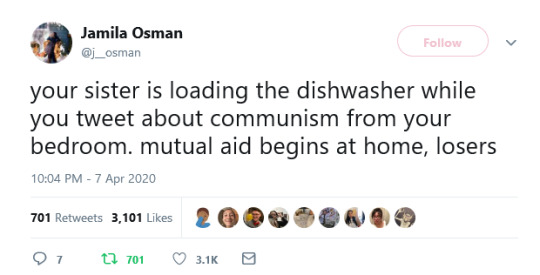
226K notes
·
View notes